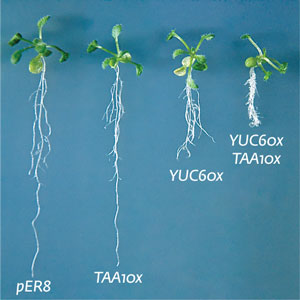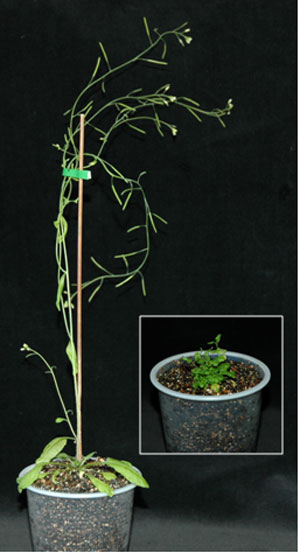Jan. 6, 2012 Research Highlight Biology
A shorter road to growth
New insights into a plant hormone synthesis pathway could prove fruitful for agricultural researchers attempting to improve crop robustness and productivity
 Figure 1: When overexpressed in Arabidopsis, TAA1 (TAA1ox) and YUC6 (YUC6ox) act synergistically to stimulate denser lateral root growth (right) relative to plants that overexpress either gene alone (middle) or negative control plants (pER8; left). © 2011 Hiroyuki Kasahara
Figure 1: When overexpressed in Arabidopsis, TAA1 (TAA1ox) and YUC6 (YUC6ox) act synergistically to stimulate denser lateral root growth (right) relative to plants that overexpress either gene alone (middle) or negative control plants (pER8; left). © 2011 Hiroyuki Kasahara
It is a rare and special treat for scientists when a process turns out to be simpler than expected, rather than more complicated. Nevertheless, this actually appears to be the case for the biosynthetic pathway underlying the production of a plant hormone with an essential role in growth and development.
Indole-3-acetic acid (IAA), a plant hormone belonging to the auxin family, activates a variety of signaling cascades involved with critical functions that include shoot growth, root extension and flowering. Consequently, this molecule has been the subject of intensive investigation for well over 70 years. However, attempts to untangle the mechanisms behind IAA biosynthesis have yielded no clear answers. “Based on the results from biochemical studies conducted from the 1960s to the 1980s, researchers have proposed multiple IAA biosynthesis pathways,” says Hiroyuki Kasahara of the RIKEN Plant Science Center in Yokohama.
Of the four mechanisms proposed to date, two have been the subject of particular interest in recent years; one is mediated by the YUCCA (YUC) protein family, and the other by TRYPTOPHAN AMINOTRANSFERASE OF ARABIDOPSIS 1 (TAA1) and a pair of related enzymes. Both pathways work with the same starting material, the amino acid tryptophan, but prior studies have suggested that YUC and TAA1 otherwise represent components of completely distinct and parallel pathways. According to this model, the former process mediates IAA production via the intermediate tryptamine (TAM), whereas the latter employs indole-3-pyruvic acid (IPA) as an intermediate product.
New findings from Kasahara and colleagues, however, have now overturned this model, revealing that YUC and TAA1 instead work together within a single, unified pathway1.
Intersecting roads
 Figure 2: Plants lacking the YUCgenes fail to produce IAA and thus exhibit stunted growth (inset) relative to their wild-type counterparts. © 2011 Hiroyuki Kasahara
Figure 2: Plants lacking the YUCgenes fail to produce IAA and thus exhibit stunted growth (inset) relative to their wild-type counterparts. © 2011 Hiroyuki Kasahara
To test the relative contributions of these two factors, the researchers generated a variety of genetically modified strains of thale cress (Arabidopsis thaliana), a species commonly used as a model plant. They found that the simultaneous overexpression of genes encoding TAA1 and YUC1 led to increased density of lateral root formation and elevated production of IAA and associated metabolic byproducts, suggesting that these two factors may act synergistically in a common pathway. Experiments in which the researchers overexpressed TAA1 alongside YUC6, a different YUC family member, yielded similar results (Fig. 1).
Given that this synergy is seemingly inconsistent with the hypothesized activities of these two enzyme families, Kasahara and colleagues examined their respective functions more closely. When the researchers knocked out a pair of proteins involved in the TAA pathway, they observed a sharp drop in IPA levels. Likewise, overexpression of TAA1 led to a concurrent increase in IPA production, supporting this protein’s established role in converting tryptophan to IPA as a preliminary step in IAA synthesis.
Their findings with YUC proved more surprising. In vitro experiments have suggested that YUC may facilitate the conversion of TAM intoN-hydroxy-TAM (HTAM), which is in turn modified to yield IAA. As expected, YUC-deficient plants showed clear signs of IAA deficiency (Fig. 2), but did not accumulate TAM as this model would predict. “Our paper shows that this initial characterization of YUC enzyme function was not accurate,” says Kasahara. Instead, these plants exhibited a nearly two-fold increase in the accumulation of IPA, suggesting that YUC enzymes instead act to drive conversion of this compound to IAA.
Isolation of fully functional YUC has posed a major logistical challenge in the past, impairing the direct assessment of these enzymes’ functionin vitro. By systematically testing different cell culture and protein preparation strategies, however, Kasahara and colleagues were able to obtain purified YUC2 and verify their hypothesis, confirming that this enzyme family acts directly downstream from TAA1 and related proteins to convert IPA to IAA. “Plant biologists have assumed that the IAA biosynthesis pathway is very complicated,” says Kasahara, “but we have demonstrated that plants can actually produce IAA in only two steps.”
Building a better plant
Although other alternative IAA biosynthetic processes have been identified, the pathway identified here is likely to operate in a wide variety of plants. Indeed, the YUC andTAA genes are evolutionarily conserved even in distant relatives of Arabidopsis, including moss and liverwort. Kasahara therefore believes that this study represents a major step towards understanding the biochemical processes that ultimately govern plant growth. “By identifying this main auxin biosynthesis pathway, it becomes possible to study in detail when and where plants make IAA by analyzing the expression of YUC family genes,” he says. “This represents an important breakthrough for plant biologists interested in learning how auxin regulates morphogenesis and environmental response in plants.”
On the other hand, the extent to which the TAM-associated pathway previously associated with YUC function actually represents a standard mode of IAA production remains an open question. Future investigations by Kasahara and colleagues will carefully explore this and other IAA biosynthetic pathways in an effort to identify novel genes that participate in the manufacture of this essential hormone.
Even at this stage, however, these findings are of more than just academic interest. By learning the core components of the auxin biosynthesis machinery, geneticists and botanists stand to gain valuable tools for manipulating growth behavior and thereby maximizing the utility of plants with essential roles in textile and food production. “One recent study has demonstrated that one can increase IAA levels during ovule development to increase the yield and quality of cotton,” says Kasahara. “We may be able to increase the production of crops by modulating expression levels of YUC and TAA genes, and the IPA pathway offers a novel target for the development of herbicides.”
References
- 1. Mashiguchi, K., Tanaka, K., Sakai, T., Sugawara, S., Kawaide, H., Natsume, M., Hanada, A., Yaeno, T., Shirasu, K., Yao, H. et al. The main auxin biosynthesis pathway in Arabidopsis.Proceedings of the National Academy of Sciences USA 108, 18512–18517 (2011). doi: 10.1073/pnas.1108434108
About the Researcher
HIROYUKI KASAHARA

Hiroyuki Kasahara was born in Fukui, Japan in 1969. He graduated from the Faculty of Science and Engineering at Kinki University in 1992, and received his PhD in 1997 from the same university. He was a research fellow of the Japan Society for the Promotion of Science from 1994 to 1997. After three years’ postdoctoral training at the Institute of Biological Chemistry, Washington State University, USA, Kasahara returned to Japan as a research scientist at the RIKEN Plant Science Center (PSC) in 2000, where he started his career in plant hormone research. Since 2005, he has been a senior scientist at PSC. In 2011 he became a research scientist of the Precursory Research for Embryonic Science and Technology (PRESTO) department at the Japan Science and Technology Agency. His research focuses on the regulation of plant growth and development using plant hormones.
